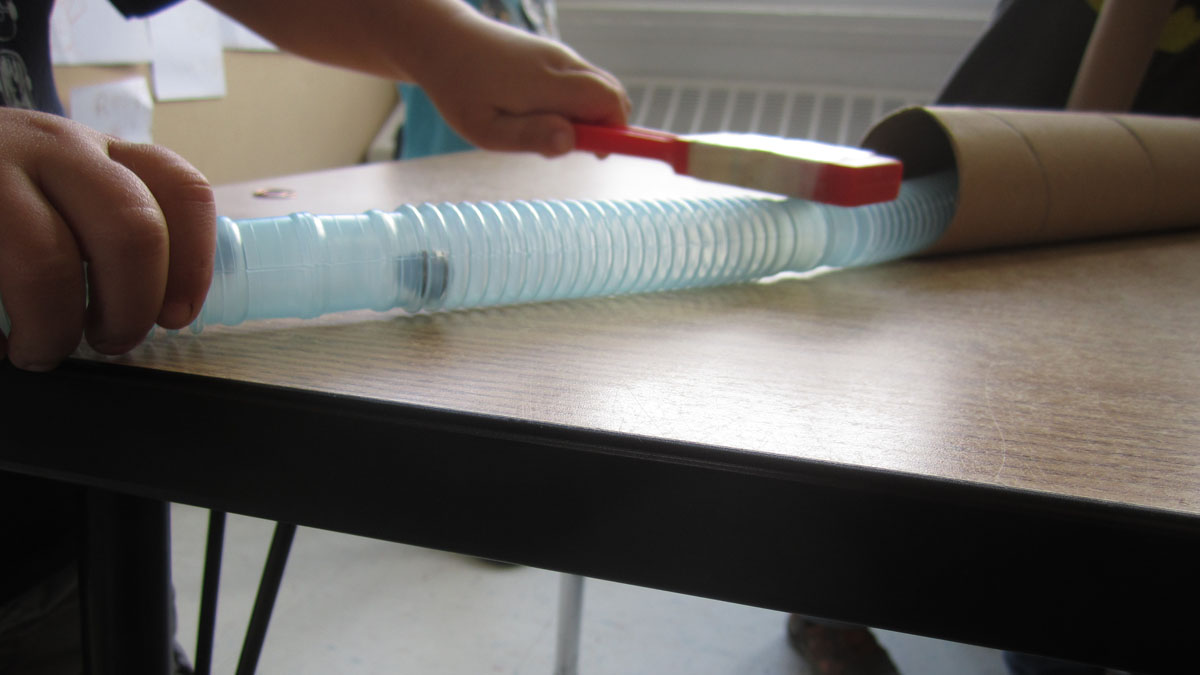The Early Years
The Early Years: Exploring Magnetism
Young children enjoy playing with magnets and using magnetism—a force that can work from a distance—to attract and move some objects. Magnetism cannot be sensed by sight, touch, smell, hearing, or taste, until a magnetic material is acting on another object. Because magnetism seems unexplainable and magical, exploring magnetism helps children understand the nature of science.
The overview matrix of the nature of science in the Next Generation Science Standards (NGSS) Appendix H presents eight major themes at grade level understandings. The K–2 grade level understandings include, “Scientists look for patterns and order when making observations about the world” and “Scientists search for cause and effect relationships to explain natural events” (NGSS Lead States 2013). Children uncover cause-and-effect relationships when they document their observations of what magnets do and measure the strength of magnets’ pushes and pulls.
Children will find that the magnets “work” for everyone, no magic words are needed, and the same actions happen each time magnets are used in the same way. Help children discuss their observations of magnetic attraction by asking them to first describe what they observe, and then tell why they think it happens. “Talk forces students to think about and articulate their ideas” (NRC 2008, p. 88). Talk moves are strategies for discussion that can help children communicate their ideas and develop them further as they reflect on what they understand (see Resources). In productive discussions, children make claims to support their arguments and listen to others. These can be short discussions that happen more than once.
Every time they test to see if an object will “stick,” children discover the relationship between the properties of matter and whether a magnet will attract an object. These patterns can be documented through writing or drawing on a T-chart (attracted/not attracted) and hands-on sorting of objects. Although they are not yet able to understand the atomic structure cause of magnetism, children will observe a consistent relationship due to the nature of the materials—i.e., plastic objects are not attracted but some metals are.
Another relationship children can document is the distance between a magnet and an object and the strength of the force. After extended open exploration, children will be ready to engage in a teacher-led investigation of careful measurement of how close a magnet must get to a paper clip or metal washer before the magnet will pull it, how many paper clips or metal washers can be lifted by different magnets, or how close one magnet must get to another before pushing it without touching. Through play and open exploration, children learn that magnets push and pull each other, depending on which ends of the magnets are facing each other—an exploration of polarity. Additional activities such as researching where magnets can be found in their homes and school directs children’s attention to the usefulness of magnetic force in everyday life.
Creating Magnetic Structures
- magnets of many kinds and shapes (only those too large to swallow), including classroom magnet set, flat advertising magnets, magnets with adhesive backing,
magnets with hooks attached, ring and block shapes, and clip-on magnets. (Plastic covering will keep ceramic magnets from splintering if dropped on a hard surface.) - cardboard in manageable sizes
- paper
- tape
- wire easily bendable
- string
- scissors
Objective
Children will design and build a structure or tool that uses magnetic force in some way to function.
- Provide time for open exploration over several weeks for children to become familiar with magnets’ ability to attract some materials, to push and pull, and to begin noticing
here magnets are used in everyday life. - Provide objects made of various materials for use with magnets, including metals that are attracted and metals that are not attracted. Keys, coins, and small plastic animals are especially interesting to children. Because tape and glue also make objects stick together, using the word “attracted” will help children understand that there is a force holding a magnet and object together. Children can conduct a census of classroom objects, testing them and recording their findings about whether the objects are magnetic or nonmagnetic. Children may ask, “Why isn’t this metal object attracted to the magnet?” Instead of telling children the answer, get children to think more about magnetic attraction by asking, “Is it ever attracted to the magnet? What kinds of materials are attracted?” After open exploration, depending on the age of your students, have children read more about the cause of magnetism. Children know what magnetic force is through their experience of its force. For very young children it’s enough to say, “That is the nature of the magnet material.” Natural phenomena happen consistently and in a pattern so we know it is the nature of the phenomena even if we don’t understand yet.
- When children lose interest and begin playing with the magnets, help them build on their explorations. Begin a teacher-led investigation about the uses of magnets in everyday life and a design problem that expands their understanding of magnetic force, data collection, and using magnetic force for a designed purpose.
- Ask, “If you were going to make something that needed magnets to work, what would you make?” and have children draw their ideas. Their initial ideas may be impractical but can reveal children’s understanding of magnetic force.
- Provide magnets and other materials for children to build structures and devices that use magnets for a purpose, not simply an aesthetic design. Depending on children’s age and fine motor ability, some designs may simply be attaching string to a magnet to use for “fishing” while others are elaborate “Rube Goldberg” devices. Offer help to children who need support to make their design but resist telling them how to make it. Encourage children to discuss their designs, successes, and frustrations with each other, and plan how to improve them.



